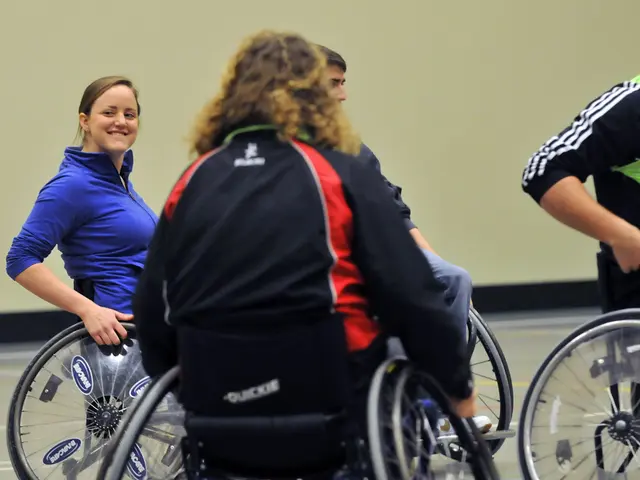Physiological Effects: Exploring the Consequences of Elevated Body Temperature
Sweating, shaking, and a rapid heartbeat - these are just a few ways your body might react when it's sweltering outside. But what goes on under the surface? When does the heat become a threat? And how can you stay cool when the mercury rises?
What Happens Inside When It's Hot?
Our internal thermostat aims to maintain a steady 37 degrees Celsius (98.6 Fahrenheit). However, external factors such as heat and cold can disrupt this balance. To prevent overheating, our bodies utilize various cooling mechanisms.
Ralf Brandes, a Professor of Physiology at Frankfurt University, breaks it down: "At cooler temperatures, heat dissipation through radiation and convection plays a significant role." Here, body heat is radiated to the surroundings or the warm air surrounding our body is carried away.
But as the heat index grows, these techniques become less effective. Then, we sweat. The human body can expel up to two liters of sweat per hour, according to Nadine Lenz, head of the Climate Change and Health project group at the Federal Institute for Public Health (BIOG).
Sweating triggers evaporative cooling, helping to maintain body temperature. Blood is also diverted from the core to the extremities to enhance cooling, resulting in flushed skin, swollen feet, or fingers.
With enough practice, you can even learn to sweat more efficiently! Regular exercise can help enhance your body's heat regulation capabilities, according to Ralf Brandes.
However, it's challenging to sweat on humid days. This is because humidity affects the effectiveness of our moisture-wicking abilities. If the air is already saturated, sweat struggles to evaporate and may linger in our clothing. In such situations, seeking relief in the coolest spaces might be the best bet.
Identifying Heat-Related Health Risks
Dizziness, headaches, exhaustion, or disorientation are common signs of excessive heat exposure, as per Nadine Lenz. Severe pallor, facial redness, nausea, shortness of breath, restlessness, or muscle pain can also be warning signs associated with heat stress.
Many of these symptoms stem from the fluid loss that comes with sweating. As Ralf Brandes explains, "If I don't drink enough, it dilutes my blood." Over time, this can lead to a drop in blood pressure and the clumping of blood cells. "This is a potentially dangerous situation, suggesting heatstroke," the doctor warns.
Some individuals may not feel thirsty, such as those on certain medications or young children who may not be able to express their discomfort. Other signs of dehydration include a dry mouth, rapid heartbeat, and dry, warm skin.
Heat becomes hazardous when the body temperature reaches 42 degrees Celsius. Interestingly, heat stress doesn't always stem from direct sunlight. "It can also occur in a sauna," says the professor.
Vulnerable Populations
- People with medical conditions: Heat places an extra burden on the circulatory system, making those with heart conditions particularly susceptible. Certain psychiatric or neurological medications may also affect sweating[1]. Dementia patients may struggle to communicate their feelings of heat and take appropriate measures to stay cool.
- Children: Young children have lower sweat production, higher metabolic rates, and more skin surface area relative to their body weight than adults. This combination means they require more time to adapt to heat[1]. Plus, they may not be able to communicate when they're too hot[2].
- Elderly: Individuals aged 65 and above find it more challenging to cope with heat[2]. Their bodies adapt more slowly to high temperatures, and they sweat later and less frequently[3]. The sense of thirst may also diminish with age, making it harder for them to recognize and respond to heat-related symptoms[3].
Protection Against Heat
To combat heat, our bodies require fluid and electrolytes. However, it's not only fluid that's essential; our sweat contains essential salts[4]. But most drinks contain less than 1 gram of salt per liter, making them insufficient for complete salt replenishment.
If you get salt cravings due to sweating, it's a good idea to indulge[4]. Isotonic drinks, while containing sugar, can help replace lost electrolytes[4].
Refrain from using alcohol to quench your thirst during hot periods, as it dehydrates the body and depletes vital minerals[1].
- Wear loose, light-colored clothes made of moisture-wicking materials to help evaporation and convection.
- Drink plenty of water to help produce sweat efficiently.
- Stay in well-ventilated areas for improved air circulation.
- Rest in shaded areas to reduce radiation exposure.
- Monitor your body temperature and environmental conditions, and modify your cooling strategies accordingly.
- Limit strenuous activities during the hottest parts of the day.
- Consult your healthcare provider about medication heat tolerance and sun protection practices.
By understanding and optimizing these mechanisms, you can better protect yourself from overheating and heat-related illnesses during hot weather conditions.
- At cooler temperatures, our bodies dissipate heat through radiation and convection, but as the heat index grows, these techniques become less effective.
- To prevent overheating, our bodies utilize various cooling mechanisms, including sweating, evaporative cooling, and diversion of blood from the core to the extremities for enhanced cooling.
- Ralf Brandes, a Professor of Physiology at Frankfurt University, explains that regular exercise can help enhance the body's heat regulation capabilities, enabling more efficient sweating.
- On humid days, however, sweating becomes less effective due to the saturation of the air, making it harder for sweat to evaporate and cooling to occur.
- Common signs of excessive heat exposure include dizziness, headaches, exhaustion, disorientation, and fluid loss due to sweating.
- If water is not replenished, blood can dilute, leading to a drop in blood pressure and the clumping of blood cells, which is a potentially dangerous situation, suggesting heatstroke.
- Some individuals may not feel thirsty, such as those on certain medications, young children, or dementia patients who may struggle to communicate their feelings of heat and take appropriate measures to stay cool.
- Hot weather can be hazardous when the body temperature reaches 42 degrees Celsius, even without direct sunlight, as in a sauna.
- People with medical conditions, children, and the elderly are more susceptible to heat-related illnesses due to lower sweat production, higher metabolic rates, and reduced ability to adapt to high temperatures.
- To combat heat, our bodies require not only fluid but also essential salts, such as those found in isotonic drinks.
- Protecting oneself from overheating and heat-related illnesses during hot weather conditions can be achieved by wearing light, loose clothing, staying in well-ventilated areas, and drinking plenty of fluids, among other strategies.








